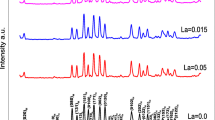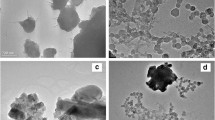Abstract
A nearly pure 2223 phase of the ceramic superconductor Bi1.8Pb0.3Sb0.1Sr2Ca2Cu3O10−δ was obtained by solid-state reaction in air. The samples showed a semiconducting behavior when the temperature was higher than 140 K. The electrical resistance began to drop at 140 K and went to zero at 92 K. Their a.c. magnetic susceptibility showed two transitions at 130 and 89 K, but the 110 K transition was absent. These transitions were stable during cycling for three times from 77 K to room temperature. X-ray diffraction revealed that there was no 2212 or 2201 phase in these samples but only a small amount of monoclinic phase before and after cycling from 77 K to room temperature. SEM images showed that the grains of the monoclinic phase segregated on the surface of the sample and at the grain boundaries inside the sample, which is the reason for the sample's poor superconductivity and the decrease in zero resistance. Evidence from TEM and SEM equipped with a wavelength dispersive meter indicated distortion of the 2223 phase. These distorted 2223 crystals may be responsible for the 130 K superconductivity.
Similar content being viewed by others
References
H. B. Liu, L. Z. Cao, L. Zhon, Z. J. Mao, W. J. Zhang, X. X. Li,et al. Solid State Commun. 69, 867 (1989).
W. R. Grace, and Co. -Conn, “Solution-phase preparation and characterization of Bi1.6Pb0.3Sb0.1,Ca2Sr2Cu3O10,”Jpn. J. Appl. Phys. 28, 1564 (1989).
M. Pissas and D. Niaschos, “Preparation of the 110 K high-T c superconductor Bi2Sr2Ca2Cu3O y , by Pb and Sb substitution,” submitted for publication inPhysica C.
B. Dabrowski, D. R. Richards, and D. G. Hinks, “Superconducting behavior and chemistry of Pb0.3B1.8−x Sb x Sr1.9Ca2Cu3O y ,”Physica C 160, 281–286 (1989).
J. S. Luo, D. Michel, and J-P. Chevaller, “Effect of Pb and Sb substitutions on superconducting Bi-Sr-Ca-Cu-O prepared by oxidation of liquid quenched precursor alloys,”Appl. Phys. Lett. 55, 000 (1989).
P. V. P. S. S. Sastry, J. V. Yakhmi, and R. M. Lyer, “Superconducting behavior of Bi1.7Pb0.2Sb0.1Ca2.0Sr2.0Cu2.8O x ,”Solid State Commun. 71, 935–938 (1989).
Chen Tinzhuet al., “Phase identification of 140 K superconducting Bi2Sr2Ca2Cu3Ox doped with Sb and Pb,”Supercond. Sci. Technol. 3, 87 (1990).
Chen Zhaojiaet al., “The search for superconductor withT c higher than 130 K,” Bei** Intern. Conf. on High-T c Superconductivity. Bei**g, 1989.
Wang **andong, Li Guobao, D-K Peng, and G-Y Meng, “Formation and superconductivity of monoclinic phase in Bi-Pb-Sb-Sr-Ca-Cu-O Systems,” submitted toSolid State Commun.
Author information
Authors and Affiliations
Rights and permissions
About this article
Cite this article
Xu, Q., Meng, GY., Yu, D. et al. The 130 K High-T c superconductor in the system Bi-Sr-Ca-Cu-O doped with Sb and Pb. J Supercond 3, 183–187 (1990). https://doi.org/10.1007/BF00624506
Received:
Issue Date:
DOI: https://doi.org/10.1007/BF00624506




